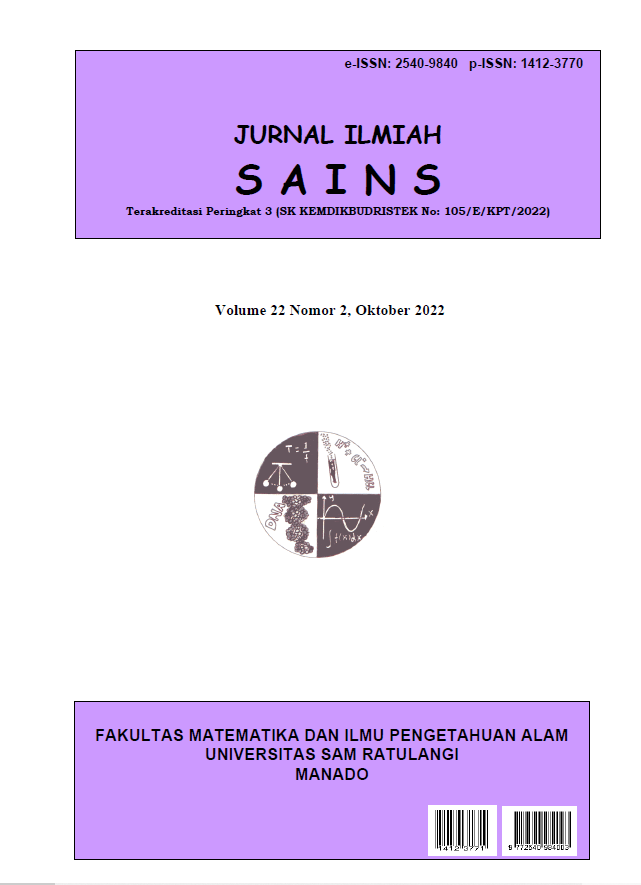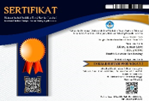The Use of SWAT Model to predict Erosion and Sediment in the catchment area of Lake Tondano
DOI:
https://doi.org/10.35799/jis.v22i2.43814Keywords:
Catchment area, erosion, sedimentation, Soil Water Assesment ToolAbstract
The Use of SWAT Model to Predict Erosion and Sediment in the Catchment Area of Lake Tondano. The objective of this research is to assess the accuracy of SWAT model to predict erosion and sediment in the catchment area of lake Tondano. A comprehensive hydrological model of SWAT is one of several models available to predict erosion dan sediment load. The validation of this model would be tested and it would be acceptable if Nash-Sutcliffe model Efficiency (NSE) coefficient was equal or greater than 0.4. The results in this experiment showed that values of NSE coefficient between sediment load observed and predicted by SWAT were between 0.4 and 0.9. Therefore, the use of SWAT model to predict erosion dan sediment in Tondano lake catchment area is satisfying and very good.
Keywords: Catchment area; erosion; sedimentation; SWAT; NSE
Penggunaan Model SWAT untuk Prediksi Erosi dan Sedimen di Area Tangkapan Air Danau Tondano
Abstrak
Penggunaan Model SWAT untuk Prediksi Erosi dan Sedimen di Area Tangkapan Air Danau Tondano. Penelitian ini bertujuan menguji keakuratan model SWAT dalam menduga erosi dan sedimen di area tangkapan air danau Tondano. SWAT (Soil Water Assesment Tool) merupakan model hidrologi yang komprehensif karena mempertimbangkan kondisi biofisik, iklim dan manajemen area tangkapan air dalam prediksi erosi dan sedimen. Penggunaan model SWAT untuk pendugaan erosi dan sedimen di area tangkapan air danau Tondano dapat diterima apabila hasil validasi sedimen terukur dan sedimen pendugaan menunjukkan koefisien NSE (Nash-Sutcliffe model Efficiency) lebih besar atau sama dengan 0,4. Penelitian ini menunjukkan bahwa model SWAT bisa digunakan untuk prediksi erosi dan sedimentasi di area tangkapan air danau Tondano karena koefisien NSE yang diperoleh pada 4 sungai yang bermuara di danau Tondano berkisar antara 0,4 sampai 0,9. Dengan demikian, pendugaan erosi dan sedimen di area tangkapan air danau Tondano dengan model SWAT dapat memberikan hasil yang memuaskan sampai sangat baik.
Kata kunci: Area tangkapan air; erosi; sedimentasi; SWAT; NSE
References
Arnold, J.G., Moriasi, D.N., Gassman, P.W., Abbaspour, K.C., White, M.J., Srinivasan, R., Santhi, C., Harmel, R. D., van Griensven, A., Liew, M. W. van, Kannan, N., & Jha, M.K. 2012. SWAT: Model Use, Calibration and Validation. Transactions of the ASABE, 55(4), 1491–1508. http://swatmodel.tamu.edu.
Bieger, K., Hörmann, G., & Fohrer, N. 2015. Detailed spatial analysis of SWAT-simulated surface runoff and sediment yield in a mountainous watershed in China. Hydrological Sciences Journal, 60(5), 784–800. https://doi.org/10.1080/02626667.2014.965172.
Cambien, N., Gobeyn, S., Nolivos, I., Forio, M. A. E., Arias-Hidalgo, M., Dominguez-Granda, L., Witing, F., Volk, M., & Goethals, P. L. M. 2020. Using the Soil and Water Assessment Tool to Simulate the Pesticide Dynamics in the Data Scarce Guayas River Basin, Ecuador. Water, 12(3), 1–21. https://doi.org/10.3390/ w12030696.
Christanto, N., Setiawan, M. A., Nurkholis, A., Istiqomah, S., Sartohadi, J., & Hadi, M. P. 2018. Analisis Laju Sedimen DAS Serayu Hulu dengan Menggunakan Model SWAT. Majalah Geografi Indonesia, 32(1), 50–58. https://doi.org/10.22146/mgi.32280.
Dai, C., & Qin, X. S. 2019. Assessment of the effectiveness of a multi-site stochastic weather generator on hydrological modelling in the Red Deer River watershed, Canada. Hydrological Sciences Journal, 64(13), 1616–1628. https://doi.org/10. 1080/02626667.2019.1661416.
Epelde, A. M., Cerro, I., Sánchez-Pérez, J. M., Sauvage, S., Srinivasan, R., & Antigüedad, I. 2015. Application of the SWAT model to assess the impact of changes in agricultural management practices on water quality. Hydrological Sciences Journal, 60(5), 1–19. https://doi.org/10.1080/ 02626667.2014.967692.
Ferijal, T. 2013. Aplikasi Model SWAT Untuk Mensimulasikan Debit Sub DAS Krueng eulesong Menggunakan Data Klimatologi Aktual dan Data Klimatologi Hasil Perkiraan. Rona Teknik Pertanian, 6(1), 398–404.
Hidayat, L., Sudira, P., Susanto, S., & Jayadi, R. 2017. Validasi Model Hidrologi SWAT di Daerah Tangkapan Air Waduk Mrica (Validation of The SWAT Hydrological Model on The Catchment Area of Mrica Reservoir). Agritech, 36(4), 467–474. DOI: 10.22146/agritech.16772.
Moriasi, D. N., Arnold, J. G., van Liew, M. W., Bingner, R. L., Harmel R.D., & Veith. T.L. 2007. Model Evaluation Guidelines for Systematic Quantification of Accuracy in Watershed Simulations. Transactions of the ASABE, 50(3), 885–900.
Neitsch, S. L., Arnold, J. G., Kiniry, J. R., & Williams J.R. 2011. Soil and Water Assessment Tool. Theoretical Documentation. Water Resources Institute.
Nguyen, B.N., & Nguyen, H.K.L. 2014. Basin resources management: simulating soil erosion risk by soil and water assessment tool (SWAT) in Ta Trach river watershed, central Vietnam. Journal of Vietnamese Environment, 6(2), 165–170. DOI: 10.13141/jve.vol6.no2.pp165-170.
Rahmad, R., & Nurman, A. 2017. Integrasi Model SWAT dan SIG dalam Upaya Menekan Laju Erosi DAD Deli, Sumatera Utara. Majalah Geografi Indonesia, 31(1), 46–55. https://doi.org/10.22146/mgi.24232.
Raihan, F., Beaumont, L. J., Maina, J., Saiful Islam, A., & Harrison, S. P. (2020). Simulating streamflow in the Upper Halda Basin of southeastern Bangladesh using SWAT model. Hydrological Sciences Journal, 65(1), 138–151. DOI: 10.1080/02626667. 2019.1682149.
Singh, A., Imtiyaz, M., Isaac, R. K., & Denis, D. M. 2014. Assessing the performance and uncertainty analysis of the SWAT and RBNN models for simulation of sediment yield in the Nagwa watershed, India. Hydrological Sciences Journal, 59(2), 351–364.
Stehr, A., Debels, P., Romero, F., & Alcayaga, H. 2008. Hydrological modelling with SWAT under conditions of limited data availability: evaluation of results from a Chilean case study. Hydrological Sciences Journal, 53(3), 588–601. DOI: 10.1623/hysj.53.3.588.
Zettam, A., Taleb, A., Sauvage, S., Boithias, L., Belaidi, N., & Sánchez-Pérez, J. 2017. Modelling Hydrology and Sediment Transport in a Semi-Arid and Anthropized Catchment Using the SWAT Model: The Case of the Tafna River (Northwest Algeria). Water, 9(3), 216. DOI:10.3390/w9030216.
Zhu, Q., Zhang, X., Ma, C., Gao, C., & Xu, Y.-P. 2016. Investigating the uncertainty and transferability of parameters in SWAT model under climate change. Hydrological Sciences Journal, 61(5), 1–17. DOI:10.1080/ 02626667.2014.1000915.
Downloads
Published
How to Cite
Issue
Section
License
Copyright (c) 2022 Johan Rombang

This work is licensed under a Creative Commons Attribution-NonCommercial 4.0 International License.
LICENCE: CC-BY-NC
This work is licensed under a Creative Commons Attribution-NonCommercial 4.0 International License







